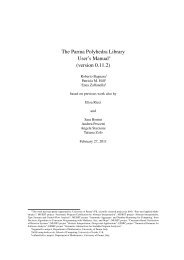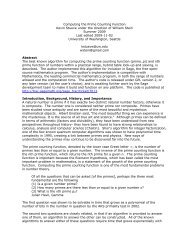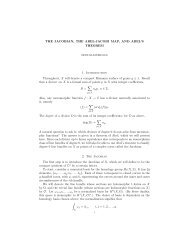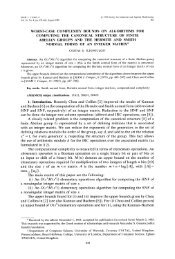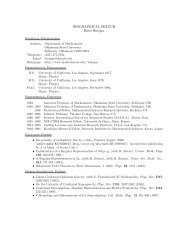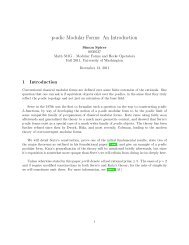Introductory Differential Equations using Sage - William Stein
Introductory Differential Equations using Sage - William Stein
Introductory Differential Equations using Sage - William Stein
You also want an ePaper? Increase the reach of your titles
YUMPU automatically turns print PDFs into web optimized ePapers that Google loves.
1.6. NUMERICAL SOLUTIONS - EULER’S METHOD AND IMPROVED EULER’S METHOD37<br />
1.6 Numerical solutions - Euler’s method and improved Euler’s<br />
method<br />
Read Euler: he is our master in everything.<br />
- Pierre Simon de Laplace<br />
Leonhard Euler was a Swiss mathematician who made significant contributions to a wide<br />
range of mathematics and physics including calculus and celestial mechanics (see [Eu1-num]<br />
and [Eu2-num] for further details).<br />
1.6.1 Euler’s Method<br />
The goal is to find an approximate solution to the problem<br />
y ′ = f(x,y), y(a) = c, (1.8)<br />
where f(x,y) is some given function. We shall try to approximate the value of the solution<br />
at x = b, where b > a is given. Sometimes such a method is called “numerically integrating<br />
(1.8)”.<br />
Note: the first order DE must be in the form (1.8) or the method described below does<br />
not work. A version of Euler’s method for systems of 1-st order DEs and higher order DEs<br />
will also be described below.<br />
Geometric idea: The basic idea can be easily expressed in geometric terms. We know<br />
the solution, whatever it is, must go through the point (a,c) and we know, at that point,<br />
its slope is m = f(a,c). Using the point-slope form of a line, we conclude that the tangent<br />
line to the solution curve at (a,c) is (in (x,y)-coordinates, not to be confused with the<br />
dependent variable y and independent variable x of the DE)<br />
y = c + (x − a)f(a,c).<br />
In particular, if h > 0 is a given small number (called the increment) then taking x = a+h<br />
the tangent-line approximation from calculus I gives us:<br />
y(a + h) ∼ = c + h · f(a,c).<br />
Now we know the solution passes through a point which is “nearly” equal to (a + h,c + h ·<br />
f(a,c). We now repeat this tangent-line approximation with (a,c) replaced by (a + h,c +<br />
h · f(a,c). Keep repeating this number-crunching at x = a, x = a + h, x = a + 2h, ..., until<br />
you get to x = b.<br />
Algebraic idea: The basic idea can also be explained “algebraically”. Recall from the<br />
definition of the derivative in calculus 1 that



